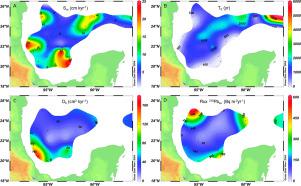Marine Geology ( IF 2.6 ) Pub Date : 2020-08-01 , DOI: 10.1016/j.margeo.2020.106288 Misael Díaz-Asencio , Juan Carlos Herguera , Patrick T. Schwing , Rebekka A. Larson , Gregg R. Brooks , John Southon , Patrick Rafter

|
Here we present new results on the sedimentation rates and vertical mixing in the deep-water region (966–3741 m) of the southern Gulf of Mexico, from a collection of 42 cores retrieved from the continental slopes and the abyssal plain. These cores were dated with the aid of accelerator mass spectrometry (AMS) 14C determinations on planktic foraminifera. We applied the Modified Mixing Box Model (MMBM) to evaluate the mean sedimentation rates (Sm), to estimate the age of surface sediments (T0) that result from mixing processes. Sm range between 5 and 9 cm kyr−1 in cores from the abyssal plain and the continental slopes, highest rates are consistently observed in specific locations on the slopes (17–24 cm kyr−1). T0 values range between 1000 and 2000 years, in cores from the abyssal plain and the continental slope sites, most probably as a result from the relatively low sedimentation rates and consequent mixing of older sediments. However, some cores from the continental slopes show consistently higher sedimentation rates, and T0 values that are close to zero age. Here we further show 210Pb profiles from 15 cores to evaluate the non-homogeneous mixing processes in surface sediments (0–10 cm). Biodiffusion coefficients (Db) derived from the solution of advection-diffusion model range between 14 and 51 cm2 kyr−1 on the abyssal plain and between 42 and 158 cm2 kyr−1 on the continental slopes.
Fluxes of 210Pbex range between 60 and 111 Bq m−2 yr−1 on the abyssal plain, and higher values are consistently found on the continental slopes (158–247 Bq m−2 yr−1). We find the age of surface sediments (T0; derived from the MMBM of 14C) are linked with the transit time in the mixed layer through biodiffusion processes, derived from 210Pb profiles. One of the implications of these results is the relative low importance of benthic macrofauna in respect to the meio- and microfauna bioturbation processes to explain sediment mixing patterns in the deep-sea sediments of the Gulf of Mexico, most probably reflecting a low export of organic carbon to the sediments controlled by the oligotrophic conditions of its surface waters.
中文翻译:

墨西哥湾南部源自14 C和210 Pb的深海沉积物的沉积物沉积速率和垂直混合
在这里,我们从墨西哥湾南部和深海平原取回的42个岩心中,得出了墨西哥湾南部深水区(966–3741 m)的沉积速率和垂直混合的新结果。这些核是通过对板状有孔虫的加速器质谱(AMS)14 C测定确定日期的。我们应用了改进的混合箱模型(MMBM)来评估平均沉降速率(S m),以估计混合过程产生的表面沉积物的年龄(T 0)。S m范围介于5到9 cm kyr -1之间在深海平原和大陆斜坡的岩心中,在斜坡的特定位置(17–24 cm kyr -1)始终观察到最高比率。T 0值的范围在1000年到2000年之间,位于深海平原和大陆斜坡部位的核心地带,最可能的原因是相对较低的沉积速率和随后的较旧沉积物的混合。但是,大陆斜坡的一些岩心始终显示出较高的沉积速率,T 0值接近于零年龄。在这里,我们进一步显示了来自15个岩心的210 Pb剖面,以评估表层沉积物(0-10 cm)中的非均匀混合过程。生物扩散系数(D b)源自对流扩散模型的解,在深海平原上介于14和51 cm 2 kyr -1之间,在大陆斜坡上介于42和158 cm 2 kyr -1之间。
210 Pb ex的通量在深海平原上介于60和111 Bq m -2 yr -1之间,并且在陆坡(158-247 Bq m -2 yr -1)上始终发现较高的值。我们发现表面沉积物的年龄(T 0;源自14 C的MMBM )与通过生物扩散过程(从210得出)在混合层中的传播时间有关。铅剖面。这些结果的含义之一是,底栖大型动物相对于中,微型动物生物扰动过程的重要性相对较低,以解释墨西哥湾深海沉积物中的沉积物混合模式,这很可能反映了有机物的低排放。碳到受其表层水的贫营养条件控制的沉积物中。











































 京公网安备 11010802027423号
京公网安备 11010802027423号